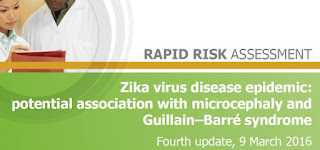#11,119
The ECDC has released their 4th Rapid Risk Assessment on the Zika outbreak, and in this 18 page PDF File you'll find their usual in-depth review of the existing literature and scientific knowledge, plus an analysis of the risks associated with the current Zika virus epidemic.
I've only posted excerpts from the summary, click the link below to download the full PDF file to read it in its entirety.
Main conclusions and options for response
Considering the continued spread of Zika virus in the Americas and Caribbean, the strong evidence of an association between Zika virus infection during pregnancy and congenital central nervous system malformations, the association between Zika virus infection and Guillain–Barré syndrome, and the risk of establishment of local vector-borne transmission in Europe during the 2016 summer season, EU/EEA Member States are recommended to consider a range of mitigation measures.
The following uncertainties have been taken into consideration in developing the proposed options for response:
- At present, there is a lack of evidence at which stage of the pregnancy the foetus is most vulnerable to Zika virus infection. Therefore the entire duration of pregnancy should be considered at risk.
- The presence of infectious Zika virus in semen has been detected up to three weeks after onset of disease; the longest interval reported between the onset of symptoms in a male and the subsequent onset of the disease thought to be due to sexual transmission in a female partner is 19 days.
- The role of asymptomatic males in the sexual transmission to women is unknown.
- The roles of different mosquito species as potential vectors of Zika virus should be clarified. If current assumptions prove inaccurate or incorrect, vector control strategies have to be adapted and revised.
Information to travellers and EU residents in affected areas
Over the past two months, and as of 7 March 2016, autochthonous cases of Zika virus infection were reported from 39 countries or territories worldwide. In the past nine months, 42 countries or territories have reported autochthonous cases of Zika virus infection.
A list of countries and territories with documented autochthonous transmission during the past two months is available on the ECDC website.
Information for travellers and EU citizens residing in areas with active local transmission
- Travellers visiting countries where there is active transmission of Zika virus should be made aware of the ongoing outbreak of Zika virus infection. A list of countries and territories with documented autochthonous transmission during the past two months is available on the ECDC website.
- Travellers visiting these countries and EU citizens residing in these countries should take measures to prevent mosquito bites indoors and outdoors, especially from sunrise to sunset when Aedes mosquito vectors are most active in biting. These measure include:
- The use of mosquito repellent in accordance with the instructions indicated on the product label.
- Wearing long-sleeved shirts and long trousers, especially during the hours when the type of mosquito that is known to transmit the Zika virus (Aedes) is most active.
- Sleeping or resting in screened or air-conditioned rooms, otherwise use mosquito nets, even during the day.
- Pregnant women and women who are planning to become pregnant should consider postponing non-essential travel to affected areas until after delivery.
- Pregnant women who plan to travel to affected areas and pregnant women residing in affected areas should consult their healthcare providers for advice and follow strict measures to prevent mosquito bites.
- Travellers with immune disorders or severe chronic illnesses should consult their doctor or seek advice from a travel clinic before travelling, particularly on effective prevention measures.
- Travellers to Zika-affected areas and EU citizens residing in affected areas should be advised that using condoms could reduce the risk of sexual transmission through semen.
Information for travellers returning from areas with local transmission of Zika virus
- Pregnant women who have travelled or resided in areas with Zika virus transmission should mention their travel during antenatal visits in order to be assessed and monitored appropriately.
- In order to protect the foetus, male travellers returning from affected areas should consider using a condom with a pregnant partner until the end of pregnancy.
- Travellers showing symptoms compatible with Zika virus disease within two weeks of return from an affected area are advised to contact their healthcare provider and mention their recent travel.
Information to healthcare providers in EU Member States
Ensure that Zika virus-infected patients in areas with Aedes mosquito vectors avoid getting bitten during the first week of illness (bed nets, screened doors and windows as recommended by PAHO/WHO).
Increase awareness among health professionals who provide prenatal care of the possible association between Zika virus and microcephaly and adapt prenatal monitoring in accordance with the exposure to the vector.
In addition, due to the unprecedented size of the Zika virus epidemic, health services and practitioners should be alerted to the possible occurrence of neurological syndromes (Guillain-Barré syndrome and other neurological syndromes such as meningitis, meningoencephalitis and myelitis according to WHO/PAHO) and potential disease complications not yet described in the scientific literature, and atypical clinical presentation among specific populations (i.e. children, the elderly, immunocompromised individuals and those with sickle cell disease).
This document also includes more specific options for substances of human origin, surveillance and preparedness, and discusses the risk of importation of the disease to continental Europe.
